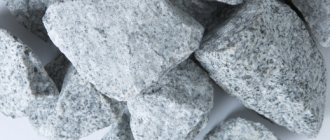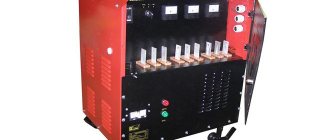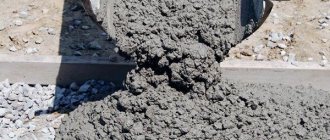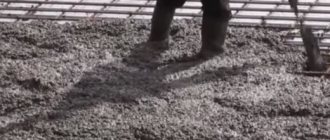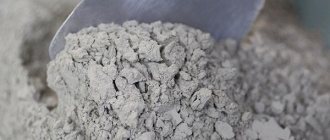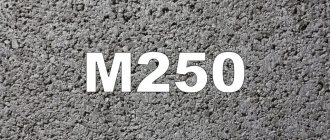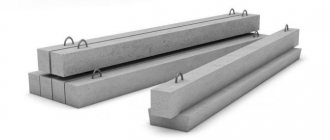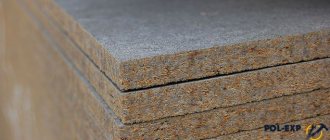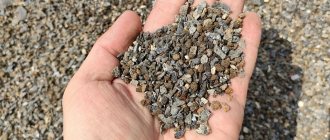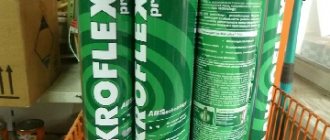— Thermomat — Warming up concrete with thermomats
The technology for the production of reinforced concrete products has been well established over the past years and is used in reinforced concrete factories and construction sites. Previously, specialists were often faced with the task of improving the quality of reinforced concrete products, but now the presence on the market of high-quality cement and various technologies for the production of prestressed concrete, vibrocompression, and centrifugation make it possible not to rack their brains too much about this; it is enough to follow already established technologies and have the appropriate equipment.
Today the questions arise:
- How to speed up the hardening of concrete?
- How to reduce the cost of concrete production?
- How to produce non-standard concrete products?
Thermomat TEM-220 for heating concrete
Size 1.2 x 3.2 m 220 W/m2
2200 2000 RUR/m2
Wholesale buyers of thermoelectric mats from 25 pcs. discount is provided.
Rent of thermoelectric mats TEM-400 from 25 pcs. Cost 300 – 500 rubles. per day for each mat.
Thermoelectric mats (TEM thermomats) are manufactured in accordance with patent No. 129744 using only high-quality Marpe infrared film of standard or increased power (from 220 to 600 W/m2), which is produced by South Korean.
Since 2014, thermomats have been classified by brand and purpose:
- Thermoelectric mats TEM-600, the most powerful for heating the soil, are made using infrared film Marpe Power 305-300 (600 W/m2);
- Thermoelectric mats TEM-400 to accelerate the hardening of concrete (manufactured using infrared film Marpe Power 305-200 (400 W/m2);
- Thermoelectric mats TEM-220 for heating concrete (manufactured using Marpe infrared film (220 W/m2);
Applications of thermomats TM-400 in the manufacture of non-standard products.
TM-400 thermomats are also used for heating concrete in the manufacture of non-standard reinforced concrete products.
The technology has already been described above, but the thermomats themselves are made to a specific mold size if its dimensions allow the operation of thermoelectric mats according to the instructions for use or are assembled from several pieces.
For example, to produce a road slab measuring 2 x 6 meters, five non-standard thermomats TM-400 measuring 1.2 x 2 meters are used, which allows them to be serviced by one worker.
When using thermomats intensively in the production of concrete products, it should be taken into account that their service life is limited due to the use of built-in temperature controllers at 70 °C (approximately 50 thousand on-off switches).
Hence the conclusion: To increase the service life of thermomats during intensive use, it is necessary to use thermomats without built-in sensors, and to use external thermostats to control the temperature.
Author of the article: Samoilov Maxim Nikolaevich. tel.+7 (915) 047-0084
Application of thermomats
- to warm up the soil before carrying out excavation work (digging holes, trenches, removing soil...). Warming up time for frozen soil ranges from 20 to 36 hours;
- to accelerate the hardening of concrete (heating up the concrete) in the construction industry and in the production of reinforced concrete products. The time to gain critical strength (70%) for a 200 mm thick slab is about 12 hours;
- combined heating , first the soil is heated with thermoelectric mats, after preparatory excavation work, concrete is poured and heated with the same thermomats.
- for heating masonry;
- for heating and maintaining the specified temperature of containers;
- for heating columns or joints between slabs;
- warming up pipeline joints before welding.
It is recommended to cover heated concrete or soil with plastic film - this prevents premature evaporation of water during the hydration of concrete and allows you to keep thermoelectric mats in working condition longer.
Warming up concrete with TM-400 thermomats in winter
Preparatory stage
- A polyethylene film is laid over the poured concrete. The film is used to prevent premature evaporation of water from concrete and preserve the outer shell.
- A polyethylene film is laid over the poured concrete. The film is used to prevent premature evaporation of water from concrete and preserve the outer shell.
- Thermoelectric mats TM-400 with a power of 400 W/m² are laid one to one on top of the film.
- Using an extension cable or other convenient method, the thermomats are connected to the power source.
The connection diagram is parallel.
Main stage
- TM-400 thermomats are supplied with a voltage of 220 V.
- In 8 – 12 hours, strength increases to 70% of r28 (strength at the age of 28 days).
When using thermomats, concrete is heated evenly throughout the entire thickness of the layer. Heating of concrete is based on the catalytic action of infrared heat. IR radiation penetrates deeply into the concrete mass and is localized in the volume limited by the formwork, due to which the process is extremely economical compared to steaming and external heating. Uniform heating eliminates the occurrence of internal stresses. In addition, there is no need for additional heating of the formwork.
TM-400 thermomats for heating concrete are equipped with built-in temperature limiters of 70 °C, that is, no additional temperature control is required. The thermomats will automatically enter isothermal mode and maintain the set parameters throughout the entire process.
- After heating the concrete, thermoelectric mats TM-400 are disconnected from the network and within 2 hours the temperature of the product gradually equalizes with the environment.
The final stage
- The thermomats are removed from the surface of the concrete that has gained strength and the plastic film is removed.
The concrete base is ready for further activities.
Read more about the operation of thermomats TM-400 in the technical description and operating instructions for the thermoelectric mat.
Specifications
| Supply voltage | 220 V / 50 Hz |
| Electrical power consumption | 220 – 600 W/m2 |
| Heating temperature, not higher | +70 °С |
| Temperature sensors for temperature limitation | built-in |
| Dimensions of a standard thermomat in working condition | 1.2 x 3.2 m |
| Folded size | 1.2 x 1.1 m |
| Weight | 2.0 … 2.5 kg/m2 |
| Operating conditions: ambient temperature of TM thermomats | — 40 °С … +40 °С |
| Operating conditions: ambient temperature of TEM thermomats | — 60 °С … + 40 °С |
| Relative humidity | up to 100% |
Application of thermomats TM-400 in the production of road slabs.
- Preparatory measures are being carried out with the form, the reinforcement frame is being laid.
- The finished concrete mixture is immersed in a lubricated mold and vibrocompressed.
- The concrete product in the mold is covered with plastic film.
- TM-400 thermomats are placed on top of the film on the product to heat the concrete.
- TM-400 thermomats are plugged into a 220 V outlet and the road slab blank is heated. This process can take from 6 to 12 hours depending on the external temperature and the brand of cement used. The average time is 6 – 8 hours.
- After the time has passed, the thermomats are disconnected from the network, but are not removed from the product and the finished road slab is allowed to cool for 2 hours.
- Then the forms are stripped, after which the finished product is moved to the warehouse.
Thermomat device
Thermal mats are made in a moisture-proof, sealed PVC shell and consist of several sections, this is done for ease of transportation and storage.
Each section of the thermomat operates independently of each other. Carbon thermal film is a source of thermal infrared energy, thermal insulation with a reflective layer creates a directed flow of radiant energy towards the heated object, a special shielding (grounding) layer increases safety, and separate thermostats-limiters in each section allow maintaining the desired temperature and increasing the reliability of the device as a whole. .
Attention!
The main condition for proper operation of thermomats is a tight fit of the working surface of the thermomat to the heated surface (concrete or soil).
Smooth bending of the thermomat without right angles is allowed.
Bend into transport position only along special lines.
Walking on thermoelectric mats and throwing heavy and sharp objects onto thermomats is not allowed!
What are thermomats
This device is designed for heating concrete and reinforced concrete blocks and structures. TEMS (thermoelectric construction mat) significantly accelerates the hydration of the mixture, preventing the deterioration of its technical properties.
Today, heating mats for concrete help workers complete the task on time and deliver a quality project in any weather conditions.
Areas of use
Warming up a concrete column with mats.
An increase in the pace of construction should not have a negative impact on the quality of the product (read also the article “Wire for heating concrete: a detailed description”).
Therefore, devices actively help in the following situations:
- When constructing horizontal floors, floors, screeds.
- During the construction of roads and squares.
- The hardening of formwork and borders is accelerated.
- High-quality coverage for airfields is being created.
- For heating various pipelines and highways.
- Warming of barrels and large containers.
- Warming up brick and stone masonry.
- Mats for heating concrete are also used for frozen soil, before excavation work.
What is the device made of?
The photo shows the structure of the mat.
- A heating layer of infrared radiation, based on a “pulse” - a polymer material.
- Air-filled heat-insulating layer.
- Heat-reflecting layer made of special material.
- Water-repellent polyvinyl chloride layer.
- Bimetallic thermostats.
The flat and flexible heating element is mounted in a PVC sheath. On one side, the structure is covered with a fairly thick (1–2 cm) heat-reflecting layer. An electrical wire with switching connectors at the end is connected to the heating layer.
Thermostats are needed to regulate the temperature. Thus, the instructions provide for automatic shutdown of the device when the temperature reaches +70⁰. When it drops to +60⁰, the thermostat turns on the mat again.
Note! Thermomats successfully replace large-sized and expensive equipment. Now you don’t need a mini-station and a transformer, just light mobile devices.
Specifications
| Characteristics | Data |
| Standard area | 3.8 m2. |
| Weight | from 2 kg to 6 kg. |
| dimensions | 320×120×1 cm. |
| Warming up to temperature | maximum +70 |
| Voltage | 220 V. |
| Power consumption during heating | 300/400 W/m2. |
Types of devices and costs
Devices for heating the soil.
In addition to devices for heating concrete, manufacturers offer device options used for the following:
- Warming frozen soil before excavation work . The device will help you prepare the soil with your own hands in just 24/36 hours.
- For heating columns and joints between concrete slabs.
- To warm a large container, as well as a pipeline of pipes.
- Mixed type heating is possible . First, the soil is prepared, then the hardening process of the poured concrete is accelerated.
As for the cost of equipment, the price may vary depending on the place of purchase. So, buying directly from the manufacturer will cost 10,000 rubles, but prices in the store may be slightly higher.
The device can be ordered complete with the accessories you need. In this case, the mats will cost you from 2,300 rubles per m2. It is often possible to rent a device; this is a convenient and economical option.
Installation and operation
Installation of mats is very simple.
Thermal mats are extremely easy to use, so if you follow the rules, almost anyone can use them.
- The equipment is unpacked and laid out in the required areas.
Note! Before and during installation, the mats must be disconnected from the power supply. Only working and serviceable sockets can be used.
- The mat is spread on the work surface exclusively with the heating surface facing down.
- Before laying the device, the concrete surface is covered with plastic film. This is necessary to prevent contamination and sticking of the mat to the solution.
- If reinforced concrete is being cut with diamond wheels along the way, all tools and devices are removed before installing the thermoplates.
- Walking on the paved surface is also not allowed.
- If there is a need to connect the mats together, as well as to facilitate vertical fastenings, eyelets will come in handy.
How it works
The device connected to the current source is considered ready for operation and begins heating.
- Since the mats are equipped with an effective heat insulator, laid correctly (heater to the working surface), they do not allow heat loss.
- When the desired temperature is reached at +70⁰, the device automatically turns off. This is done by thermal sensors that open the circuit.
- As soon as the device cools down to +55/+60⁰, the circuit closes again, bringing the thermomat to the desired temperature.
- Several elements connected to each other have independent temperature sensors, which adds convenience to operation.
- The mats have a grounded plate that distributes heat. Even with a loose fit, the quality of heating does not suffer.
If you plan to diamond drill holes in concrete, the heating device should be temporarily turned off and removed from the working surface.
